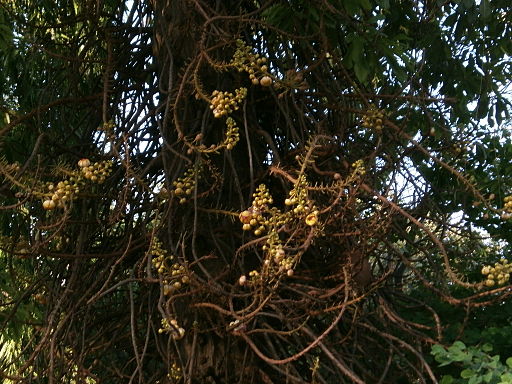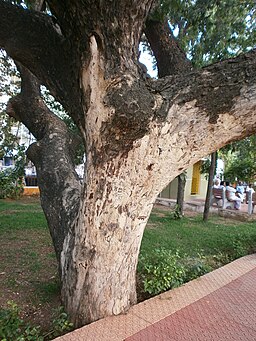Sivan Park, KK Nagar, Chennai: Nizhal Tree Walk

Sivan Park is a nice little park in KK Nagar, Chennai that has a surprisingly strong green cover. Google Maps (Location). Nizhal is an organization that works for increasing awareness about the need to preserve and grow trees/plants (especially in urban areas). With support from active volunteers, they execute direct planting initiatives and do much more to promote tree culture and regenerate bio-diversity in our urban centers.

Ever since I went to the tree walk organized by Nizhal at Kalakshetra, last year, I have been wanting to go to another one. This year’s Madras Day celebrations provided that opportunity. I have not been to the Sivan Park earlier, so I registered to go to this particular walk. The first photo shows a large statue of God Shiva, which maybe the reason for the name of this park. I should say that this park is better than what I expected to find – there were so many families walking and a large kid’s play area, too.

There are so many species of trees (in parks around us) but we are not be able to identify them. The objectives of a tree walk is to (also) help us identify some of them. The above photo shows the leaves of a tree called Tabebuia. It’s an exotic tree (native to Central America, but brought and planted here) and we can identify it by the pattern of its shiny leaves – see the hand shaped pattern with different leaf sizes, above?

These are the leaves of a tree called Illuppai (Madhuca). It’s seeds are similar to suppotta’s and they were extensively used to make oil (to light lamps) before about 700-800 years. Its flowers are used as a sweetener and its fruits are very tasty and induce drowsiness to animals that eat it. It seems monkeys and other animals like it very much.

These are the leaves of a tree called Indian Peach (Deech?) or Pungam. It’s leaves have spots due to fungal growth, but it’s just cohabitation and the fungus doesn’t affect the leaves. It seems these leaves have medicinal properties and can refresh our body – it’s good to sleep under their shade. These leaves are also used as green manure. We also saw two more trees – Mavilingam/Garlic pear tree, which flowers from May to July and Badminton ball tree (native to West Africa) which grows tall and has numerous short and well arranged leaves.

The above photo shows the Nagalingam/Cannon-ball Tree. It’s named so because of the large (miniature) cannon-ball type fruits. It seems, traditionally, our ancestors grew certain types of sacred trees at Shiva Temples, and this was one of them. Basically, this was done to maintain the biodiversity (a word that mostly exists in text books these days {ironically made from wood got by cutting trees}).


The above two pictures show the trunks of a Rain tree & a Banyan Tree, respectively. See what people have done to them – They have peeled off the outer protective layer of wood, in the first case and they have scribbled nonsense on the trunk of the second! These irresponsible practices affect trees very much. People are also advised not to nail advertisements on trees or wrap them with lights.
The rain tree (thungu moonji maram) is a large tree that is happily grown in the road-sides because of the amount of shade a single tree can give. There is an interesting story behind its name – It seems, a certain species of insects called ‘Cicadas’ live in them (in their native – Central America) and they pee a lot, ejecting huge volumes of sugary-water that falls like rain on anything sitting under its shade – Animals even drink this water. But when we brought the tree, we forgot to bring the insects, here!
The banyan tree (Aala maram), of course, is the queen of all trees because of the number of species a single tree can support and the extent over which it can grow. Did you know that the banyan tree is our national tree? The state tree of Tamil Nadu is Palm tree. This tree belongs to the ficus family (whose flowers turn into fruits) and each fig variety has a specific variety of wasps (vandu) and only that insect can pollinate its flowers.

The next tree we saw was the white silk cotton (elavam panju) tree. A fallen fruit from this tree is shown in the above photo. Our pillows are made using the silk cotton obtained from these trees. We also saw the Indian Tulip (Poovarasu) tree which of course has flowers and gives hard, termite-proof wood. It seems – Indian Tulip, Neem and Pungam are our native trees and can easily be grown in our road-sides/gardens.
The oldest (surviving) flowering tree is a Pipal tree (Arasa maram) that was planted in Sri Lanka by Ashoka’s daughter Sangamitra, more than 2300 years ago. So, there are trees that can live that long!


The first photo shows the Copper Pod tree, which is a large tree and is used to make shields. The second photo shows the Indian Ashoka Tree that grows narrowly vertical – It can reach good heights and also looks like an ornamental plant. It prevents noise pollution and dust, hence people love to plant it all along the perimeter of their property.
Trees can live without us – but we cannot live without them. Let’s save whatever trees remaining in our urban spaces and lets plant new ones 🙂
Destination Infinity

Thanks for introducing this nice park. When we think of modern Chennai, comes to our mind is flats, flats, flats, and traffic jam, traffic jam, and traffic jam.
That’s why some good organizations like Nizhal are conducting tree walks – to sensitize people about growing/retaining more trees in urban spaces.
Destination Infinity
An Informative post on trees. I usually look at the placards when I go to the botanical gardens. Though the one in Kolkata looks close to a jungle.
Here, I have not seen any form of placards at all, in parks. High time they start putting them.
Destination Infinity
Nice post 🙂
Regards
Thank you 🙂
Destination Infinity
This park is not far from my house.I had been there several times.But your post gave me a new insight.
Next time I go there,I will see it in a different light.Thanks a bunch
It’s good to have such a nice green park near home. I have one near my house as well, but the number of trees there is very less. But there is more open space and a pond 🙂
Destination Infinity
Very interesting post, D.I. Have you seen Nochchi maram? Mosquitoes hate its leaves, it seems! I might have seen but don’t remember.
It was nice to know informations of so many trees. I wonder when our people will learn to preserve whatever trees we have. The writing on the trunks is disgusting.
Many people still use iluppai yennai for lighting up lamps, I have heard.
Thank you, D.I. for the nice post.
I have seen nochi maram during the last year’s tree walk at Kalakshetra. Yes, we need to preserve and grow as many trees (or at least plants) as possible. Interesting to know that people still use iluppai yennai for lighting up lamps. I am coming across this oil for the first time!
Destination Infinity
We have Nochchi maram in front of our house, but they do nothing with mosquitoes… rather its leaves has medical value and are eatable for knee pain. Its Nochchi plants that control the mosquitoes, not the tree.
beautiful park
Thanks SM 🙂
Destination Infinity
great park…
thanks
Yes, it’s a nice park indeed 🙂
Destination Infinity
Ha wonderful post 🙂 I came to know about ‘Nizhal’ organisation since I started blogging, they are doing amazing works. I was trying to attend their tree walks, but haven’t got the opportunity yet 🙁 Waiting for the next tree walk.
”Trees can live without us – but we cannot live without them” – well said and true fact 🙂
Yes, do go to one tree walk conducted by Nizhal whenever possible. You an get a lot of knowledge about trees 🙂
Destination Infinity
The last line says a lot! Great knowing about this park and its number of trees… Interesting facts and detail about the trees that seen commonly.
Yes, do visit the park sometime… 🙂
Destination Infinity
Informative post DI.. how do you find out about these org or walks? I am hardly aware of such events around.. Thanks for sharing so many interesting facts about trees.. This park reminded me of Lalbagh in Bangalore. Hope to visit this park sometime.
Such info about local events is available in facebook (some groups/pages), newspapers, sites like allevents.in, etc. Basically, if you want to go out somewhere in the weekends and aren’t in a position to stay at home, you’ll somehow find such events 🙂
Destination Infinity
We moved to Alwarthirunagar a few years back but KK Nagar is where I grew up and drove past Sivan park everyday. We lived near Pondicherry Guest house. Thank you for this informative post. Now I’m homesick as well…
I am not familiar with the area as i live elsewhere, but good to know that you lived in KK Nagar. You can always visit home during summer vacations… 🙂
Destination Infinity
wow and good maintenance good
Would any of you know the distance of the walking strip around the park?? thanks
I thank you for publishing such an informative and interesting post about the flora found in the Sivan Park. It helped me to learn about many different trees as well as helped me to do my project works. Once again, I thank you so much.
What a delightful post! 😊 I recently discovered the ‘Nizhal’ organization through my blogging journey, and I’m truly impressed by the incredible work they’re doing. I’ve been eager to attend their tree walks, but unfortunately, I haven’t had the chance yet. Looking forward to joining the next one! As you said, “Trees can live without us – but we cannot live without them” – such a profound and undeniable truth.